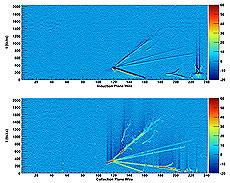ArgoNeuT experiment sees first neutrino interactions

A screen capture of ArgoNeuT's first neutrino interaction event, as seen by induction and collection wire planes in the detector.
An experiment that could help revamp the Intensity Frontier recently took a big step forward.
The Argon Neutrino Teststand, or ArgoNeuT, uses technology that could be key to unveiling the role that neutrinos played in the early universe. The experiment, which could help make the case for larger, more powerful detectors, recently recorded its first neutrino interactions, the first ever seen in a liquid-argon detector in the United States.
"Liquid-argon detectors can achieve high accuracy in determining the type of particle interaction. Because of this, they are very good at rejecting background events. These detectors can also get the same measurements as much larger detectors that use different technologies," said Brian Page, a graduate student at Michigan State University who works on ArgoNeuT.
ArgoNeuT, a small, 175-liter, liquid-argon-filled detector, sits upstream of the MINOS detector in the neutrino beamline. Neutrinos from the NuMI beamline enter the ArgoNeuT detector chamber and interact with argon atoms. The interactions produce light and charged particles, which continue to travel through the argon and knock electrons loose. A wire plane attracts these electrons, which induce electrical signals. The data collected helps scientists reconstruct a 3-D image of the original interaction event.
Scientists lowered the experiment, commissioned in 2008, into a detector hall in January 2009. It was filled with liquid argon this May, and saw the first interactions on May 27.
"Seeing the neutrino interactions is another step towards showing us that we can build these detectors for the long baseline neutrino oscillation program at the proposed Deep Underground Science and Engineering Laboratory," said Bonnie Fleming, ArgoNeuT spokesperson.
ArgoNeuT's research results will help to develop larger liquid-argon detectors. ArgoNeuT scientists will test argon purification techniques and develop software to correctly identify and analyze the interactions.
"ArgoNeuT is a nice stepping stone," said Mitch Soderberg, a post-doc from Yale University who works on ArgoNeuT. "Then we're ready to get to MicroBooNE, a much larger liquid argon detector that has been approved to run here at Fermilab."
-- Tia Jones
|